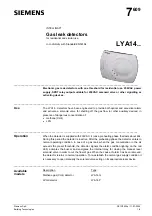
27
• If the metal detector beeped when you were tuning the pointer, it will stop beeping when the pointer is in the zero
position. Other settings can be configured when the metal detector is in use; see the following sections for details.
• Press the push button (7) again if you need to reset the pointer to the zero position during use.
Adjust the setting when the ambient conditions change (e.g. when you move from dry to wet ground).
Surfaces with a high iron mineral content have ferromagnetic properties. These ferrous surfaces generate
a signal in the metal detector, which may be stronger than the signal emitted from a metal object. This
phenomenon usually occurs in surfaces with large amount of salt water. However, these surfaces have a
constant phase shift, meaning that it is possible to distinguish a metal signal from the background signal
when the metal detector is calibrated correctly.
d) Setting the discrimination - DISCRIMINATION
The metal detector can be used to determine different types of metals. It can distinguish between ferrous and non-
ferrous metals.
• Turn the
DISC
(15) dial clockwise to the middle of the scale. This allows you to distinguish between different types
of metals in most scenarios.
• Turn the
DISC
dial (15) clockwise to distinguish between different metals. The discrimination setting is at the
maximum level when the dial is turned as far as it will go.
• You can move the dial to another position as desired.
When you change the discrimination setting, the metal detector needs to be retuned (see "Basic setting
- TUNE").
e) Testing reactions to different types of metals
Before searching for metals, you need to learn how the metal detector reacts to different types of metals and their
location/distance. In order to do so, you should conduct a range of tests with different metals and detection angles. Do
not test the metal detector on floors or ceilings, as these often contain metal parts. For best results, we recommend
placing the test objects on a wooden table. Before searching for metals, test the metal detector on different types of
metals (e.g. coins, rings and silver cutlery) to familiarize yourself with how the metal detector works.
• Before conducting a test, remove sources of interference such as jewellery, watches and rings.
• Place the metal detector on a plastic or wooden table and ensure that there are no nearby metals that may cause
interference. Align the detection probe (1) so that the flat side is pointing upwards.
• Move the metal test object backwards and forwards over the search probe at a low height.
• When the metal detector detects an object (e.g. watches, rings, jewellery, copper, gold, silver or scrap iron),
memorise the optical and acoustic signals and the distance of the object from the search coil. Practice until you are
confident interpreting the optical and acoustic signals.
• Hold the metal test object at different angles and note how the acoustic signal changes.
• Repeat this process with test objects made of different metals.
















































